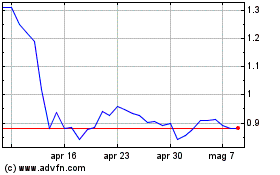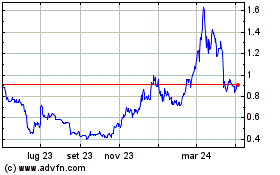Bitcoin Open Interest Falls To $37 Billion—Does This Spell Trouble For BTC?
21 Marzo 2025 - 9:30PM
NEWSBTC
Open interest in Bitcoin trading is a crucial metric to assess the
market’s current sentiment on the digital asset, including
potential price movements. In theory, an increase in Bitcoin’s open
interest suggests liquidity, which can also support an ongoing
price trend. According to the latest Glassnode data, Bitcoin’s OI
has dipped from $57 billion to $37 billion, or a loss of 35%, since
the world’s top digital asset hit its all-time high. Related
Reading: XRP Turnaround Moment? Analyst Says It’s Lift-Off Time
Interestingly, Bitcoin hit an all-time high of $108,786 on January
20th, the day United States President Donald Trump was inaugurated
for a second term. Bitcoin is trading between $83k and $86k, down
more than 22% from its peak, at the time of writing. Bitcoin
Open Interest And Its Possible Impact On Price Investors and
holders use the open interest metric to assess the sentiment and
potential market performance of the asset. A digital asset with a
falling open interest means that traders and investors are closing
their positions due to uncertainties or lack of confidence or are
moving away from leveraged trading. Futures open interest has
dropped from $57B to $37B (-35%) since #Bitcoin’s ATH, signaling
reduced speculation and hedging activity. This decline mirrors the
contraction seen in on-chain liquidity, pointing to broader
risk-off behavior. pic.twitter.com/XPbXiHXlRS — glassnode
(@glassnode) March 20, 2025 In Glassnode’s analysis, the drop in
Bitcoin’s OI reflects a broader trend of decreasing on-chain
activities and liquidities, where investors have less confidence in
the asset. Bitcoin’s current status suggests that most investors
are now looking at short-term trades for quick gains at the expense
of long-term positions. There’s A Shifting In Positions – Glassnode
According to Glassnode, traders and investors are now in the
cash-and-carry trade, with a weakening of long positions. It adds
that the CME futures closures and ETF outflows reflect a shift in
investors’ strategy and also add to the selling pressure. Also, the
availability of ETFs, which have less liquidity than futures, may
impact the alpha crypto’s short-term market volatility. Data
Highlights Hot Supply Metric Glassnode also highlighted the asset’s
Hot Supply metric. This is another important metric that tracks the
Bitcoin holdings at one week or less. According to the same
Twitter/X thread, the numbers have dropped from 5.9% of the total
BTC in circulation to 2.8%, reflecting a drop of more than 50% in
the last three months. The decline in the hot supply suggests that
fewer new Bitcoins are traded in the market, reducing the asset’s
liquidity. Related Reading: 1 Million Bitcoin In New Whale Hands—A
Mega BTC Rally On The Horizon? Glassnode further painted a gloomy
picture for Bitcoin by explaining that exchange inflows have
dropped from 58,600 Bitcoins daily to 26,900 Bitcoins, a 54%
decrease. This Bitcoin trend suggests weaker demand since fewer
assets are moving to crypto exchanges. Featured image from Olhar
Digital, chart from TradingView
Grafico Azioni Flow (COIN:FLOWUSD)
Storico
Da Mar 2025 a Apr 2025

Grafico Azioni Flow (COIN:FLOWUSD)
Storico
Da Apr 2024 a Apr 2025
